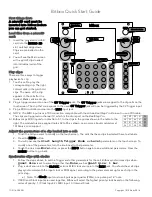
26
CHAPTER 6: PROGRAMS
WHAT IS A PROGRAM?
A MINIAK program is a sound built from the MINIAK's internal oscillators, filters, and envelope generators.
The MINIAK's programs cover the gamut of classic analog synthesis sounds. If you've heard it before, you
will probably find it amongst the MINIAK's presets.
HOW THE MINIAK MAKES SOUND
The MINIAK generates sound by emulating, or "modeling," the behavior of an analog synthesizer. Oscillators
generate the raw sounds. The oscillators are then fed into the filters, which in turn are fed into the amplifiers.
As the signal moves through that basic path, you are able to adjust the mix of the signal at several points,
apply various modulations and envelopes, and add effects. In this way, the MINIAK can generate a virtually
limitless variety of sounds.
Let's take a quick look at the MINIAK's signal path, from start to finish.
The Oscillators
The oscillators are where sound is born. You may have heard that what you perceive as "sound" is simply
vibrating air molecules hitting your eardrums. That vibration has to start somewhere, and in the Ion, it comes
from the oscillators. By varying the
frequency
of the vibration, the oscillators can produce different pitches,
which are heard as musical notes. By adjusting the
waveform type
and
shape
, the oscillators can produce
various harmonics, which are heard as different timbres. Each of the MINIAK's voices contains three
oscillators.
The Pre-Filter Mix
The outputs of the oscillators, as well as a few other signal sources, are fed into a virtual mixing board called
the Pre-Filter Mix. The job of this mixer is to funnel all of these sources into the inputs of the next sound
processing stage – the filters. For each source, you can specify its
level
, which is how loud it should be, and
its
balance
, which determines how much of it goes to Filter 1 and how much to Filter 2.
The Filters
The sound produced by the oscillators is very raw, and usually not suitable to be used directly in an
instrument. In order to bring out the sonic textures you have in mind, you will typically want to dampen
certain harmonics and boost others. This is where the filters come in. Filters alter the frequency content of
the signal, and can have a drastic effect on the sound. A filter typically allows you to adjust its
cutoff
frequency
, which represents the range of harmonics that the filter operates on, as well as its
resonance
,
which determines how much boost is given to harmonics around the cutoff frequency. Each of the MINIAK's
voices contains two filters, and each filter can be one of eighteen different types, each with its own character
and sonic flavor.
The Post-Filter Mix
The outputs of the filters need their own virtual mixing board as well, and that's what the Post Filter Mix is for.
For each filter output, as well as a pre filter signal of your choice, you can specify a
level
, which is how loud it
should be, and a
pan
, which determines how much goes to your left speaker and how much to the right.
Output
The sound is getting near the end of its journey, but still has one more processing stage to go through. In the
output stage, the MINIAK allows you to apply a
drive effect
, to give the sound a final push and add some
compression, distortion, or other amplification effect. You also get to choose the overall level for the sound,
as well as how much of it gets sent to the MINIAK's dedicated effects processor.
Содержание MINIAK
Страница 1: ...WWW AKAIPRO COM REFERENCE MANUAL ENGLISH 1 55 ...
Страница 2: ......
Страница 58: ......
Страница 59: ......
Страница 60: ...WWW AKAIPRO COM ...














































